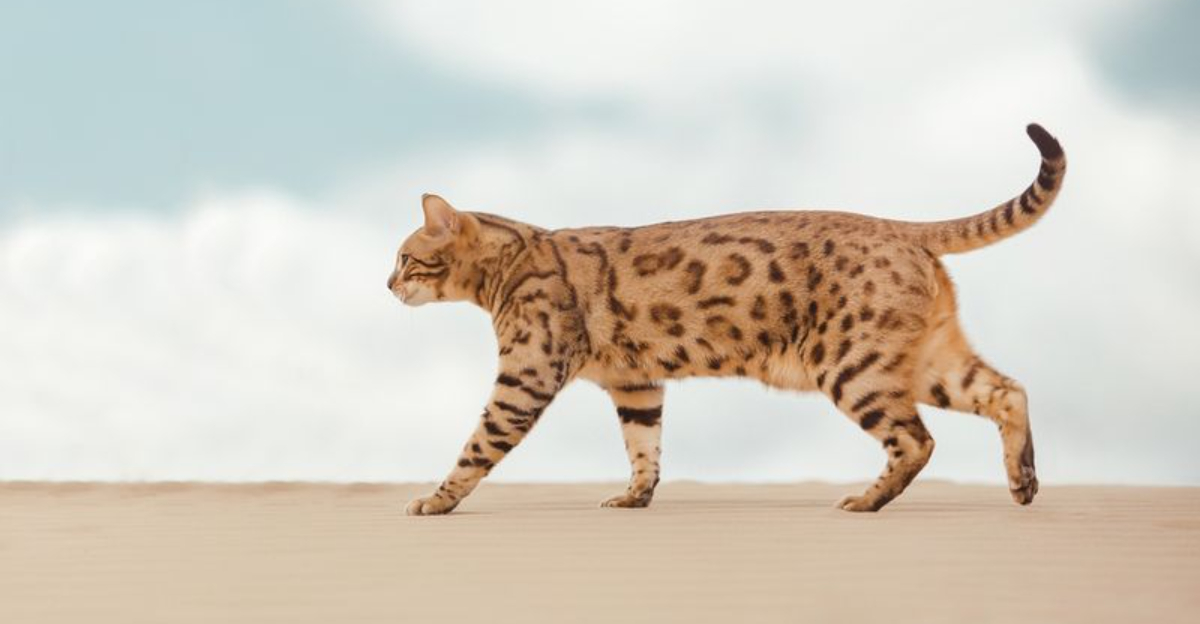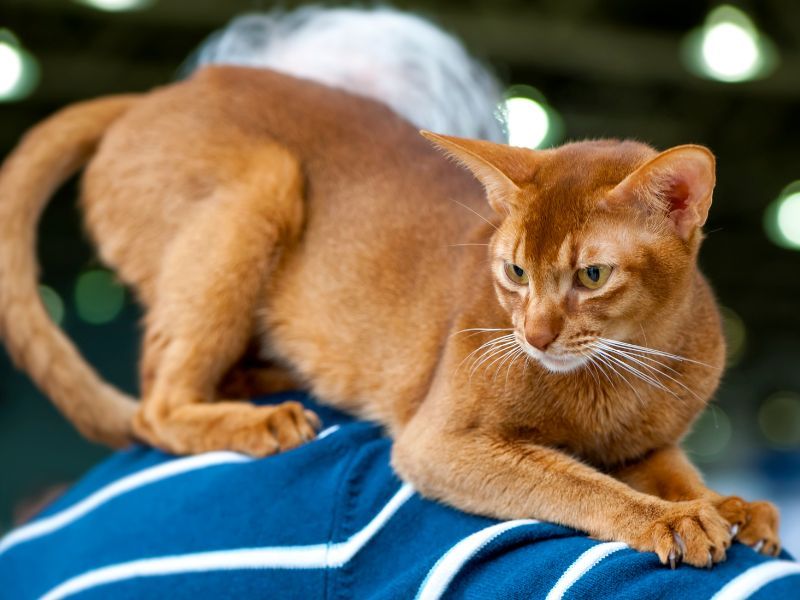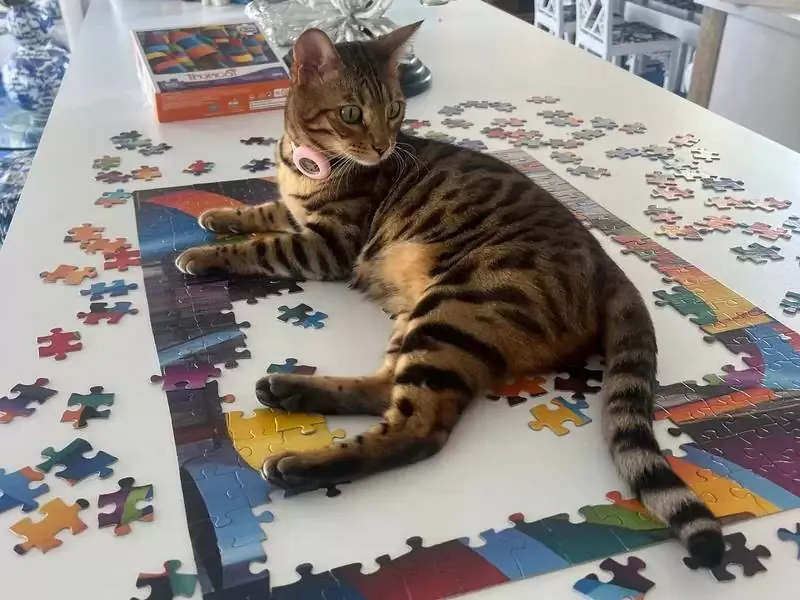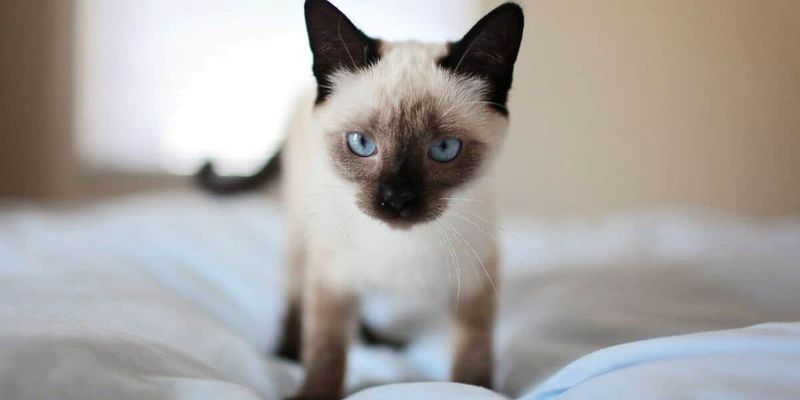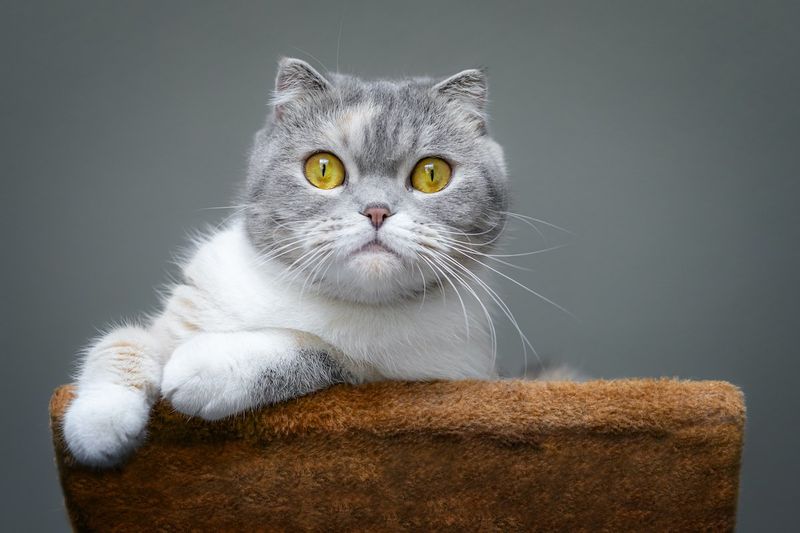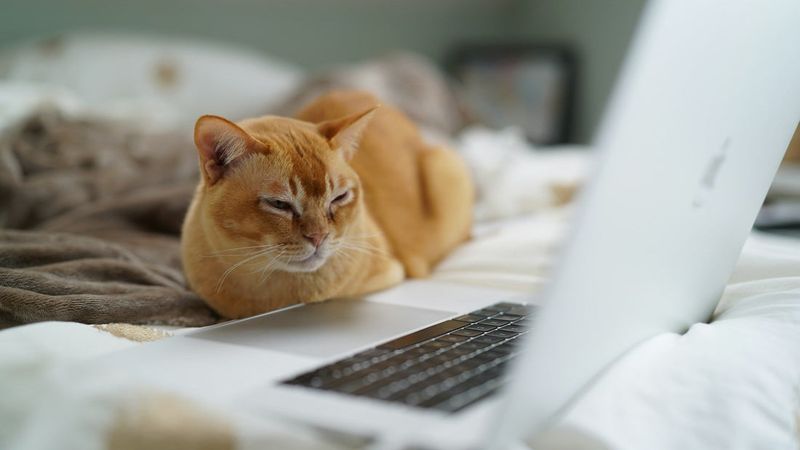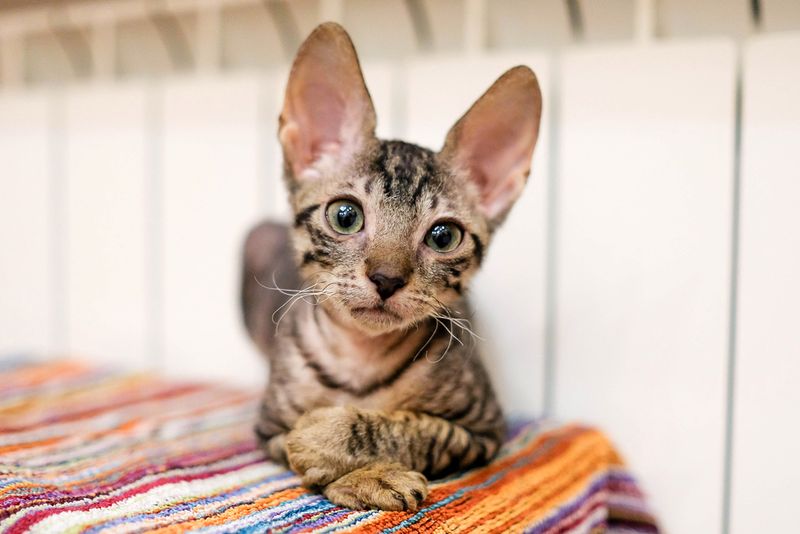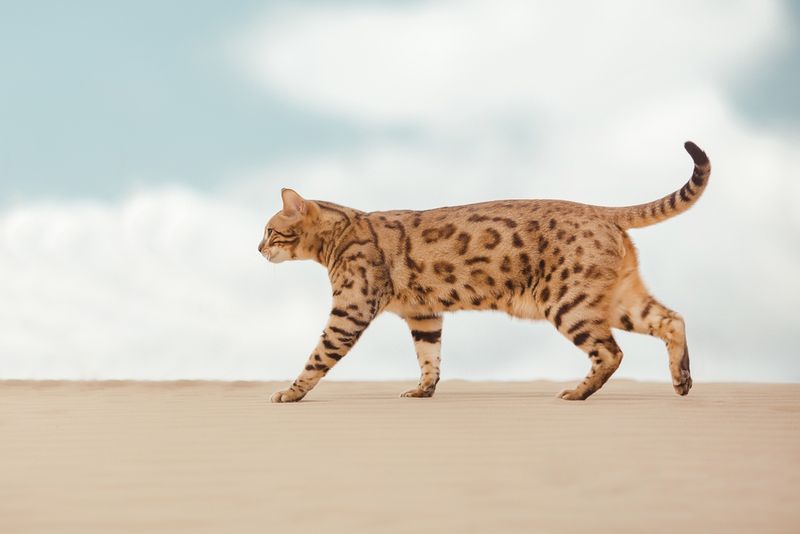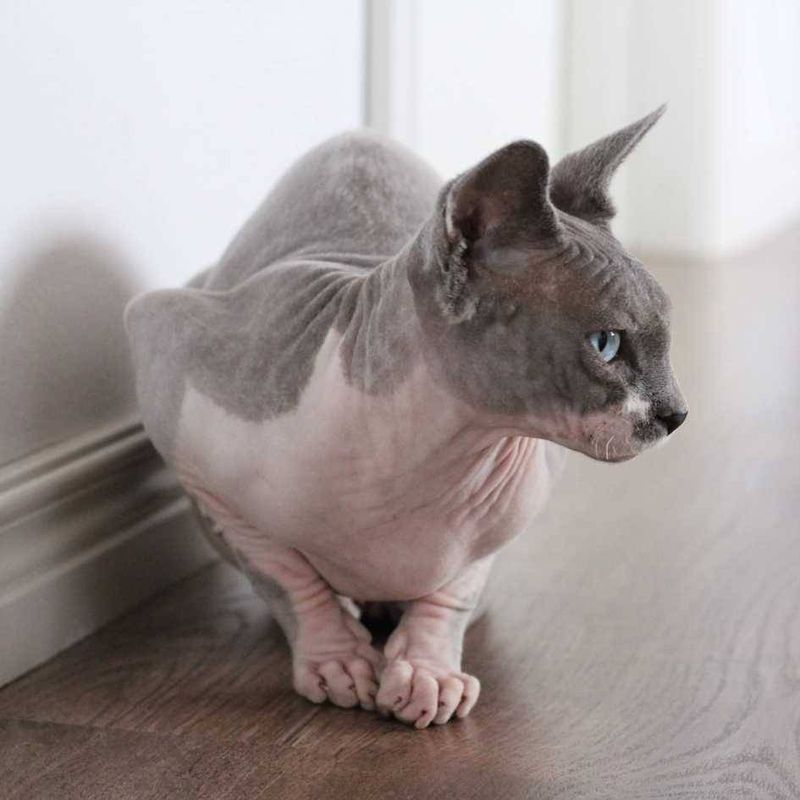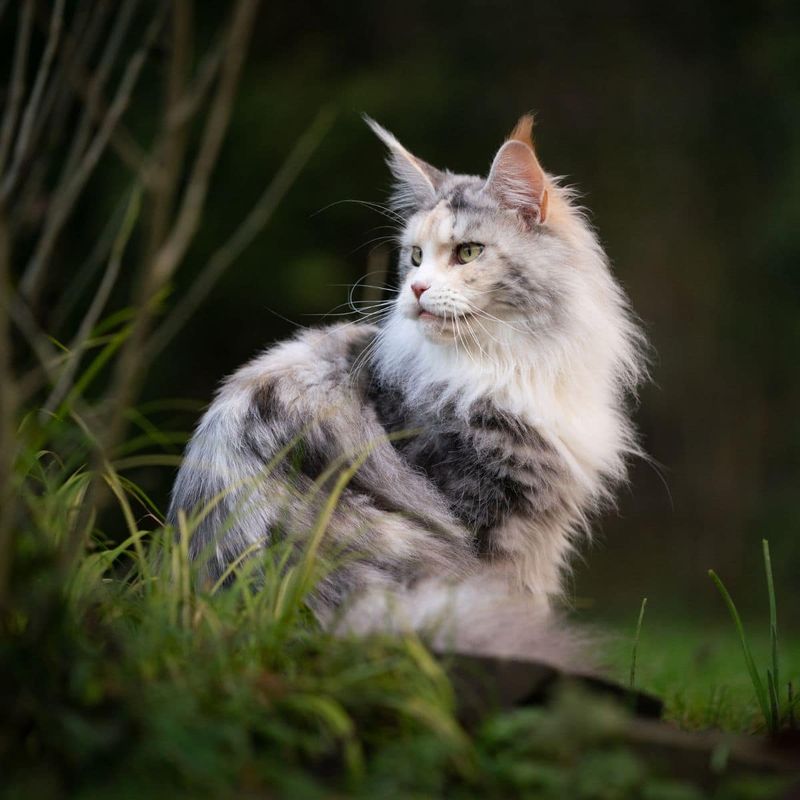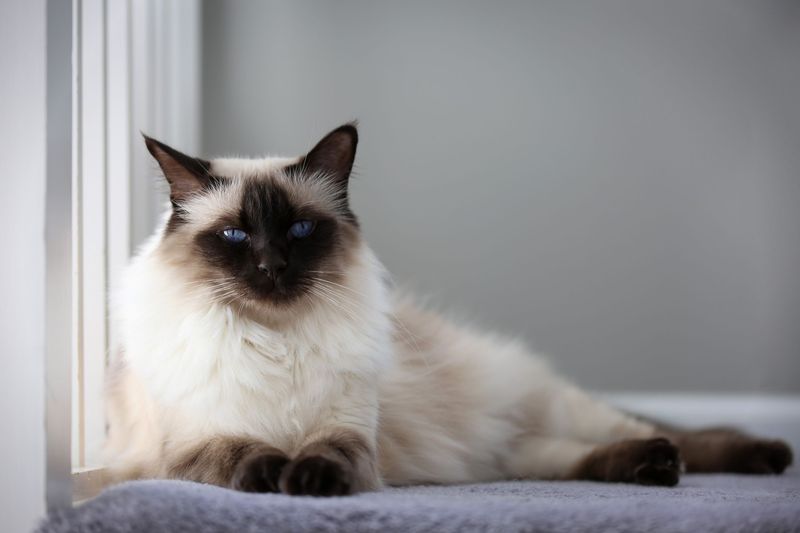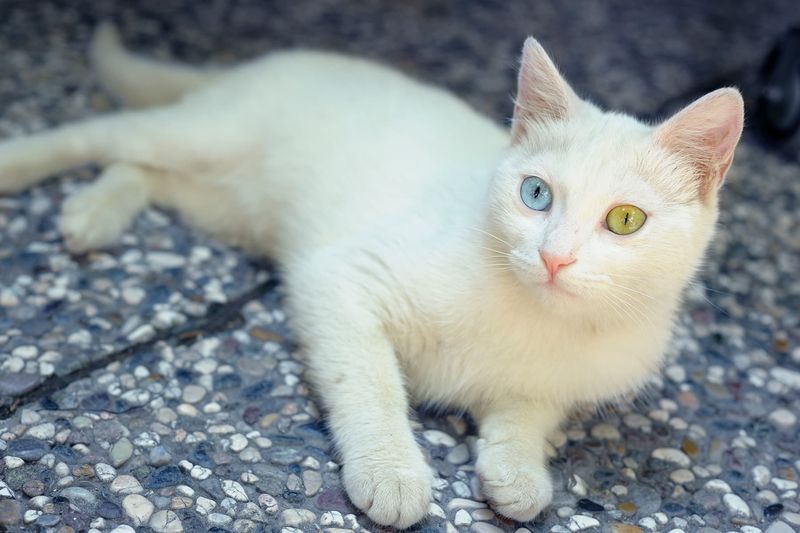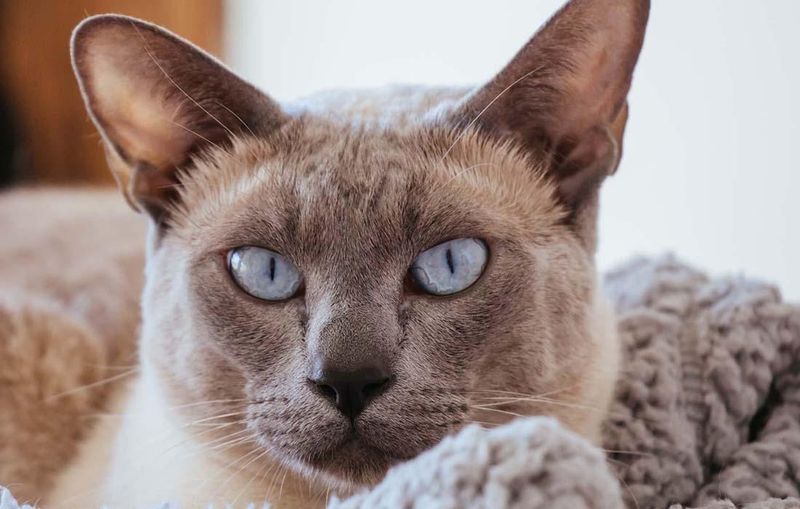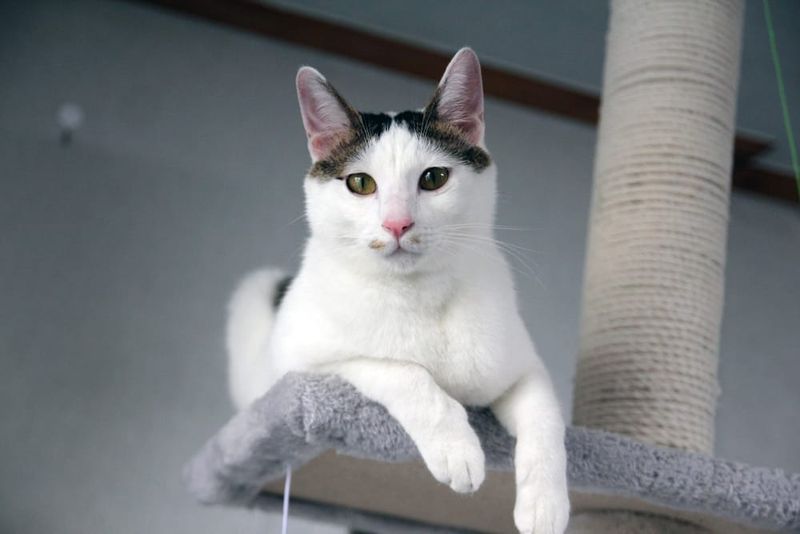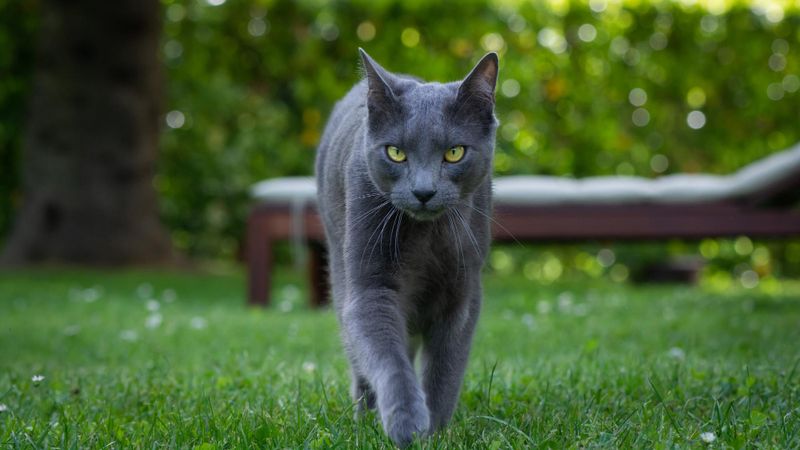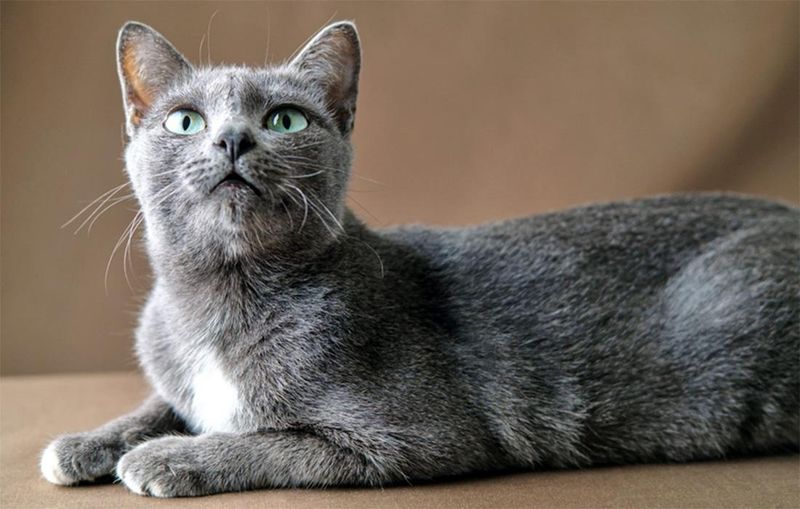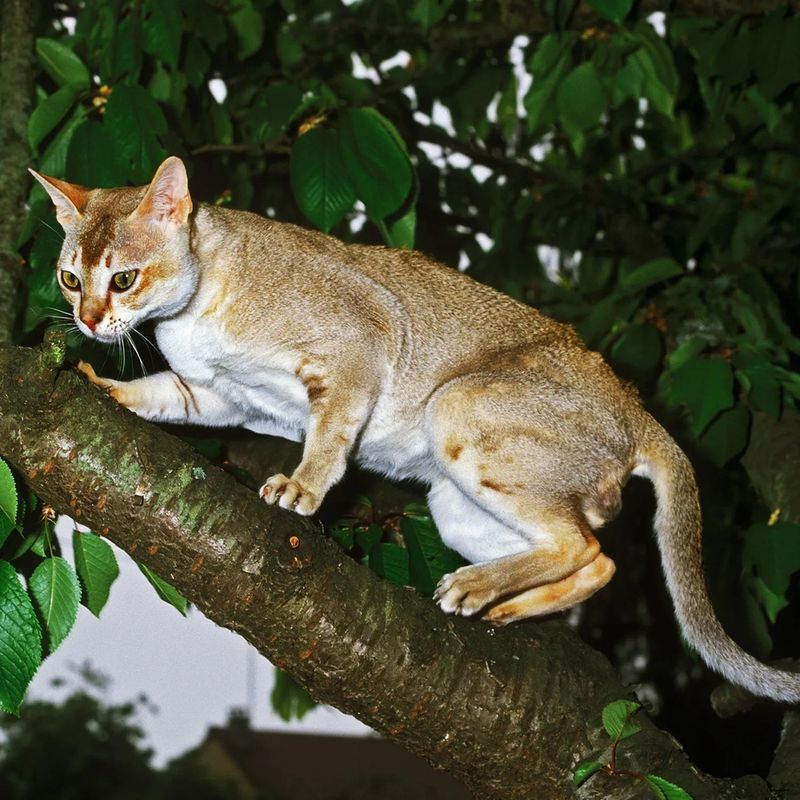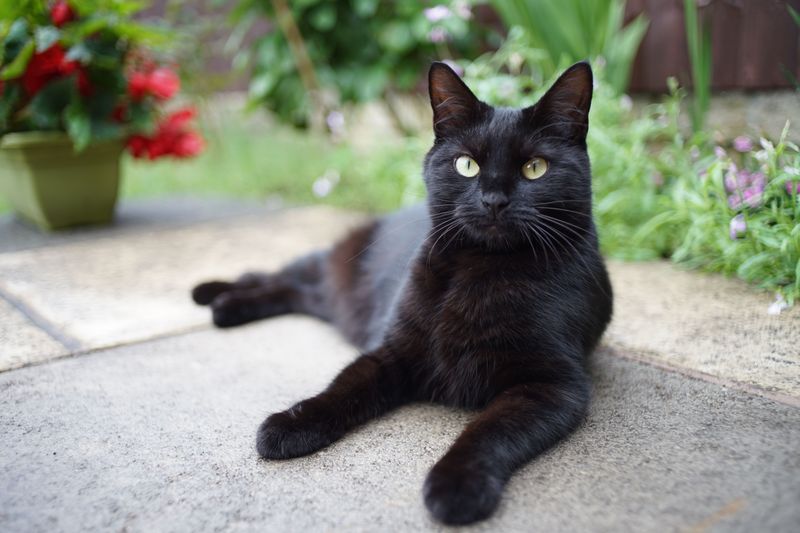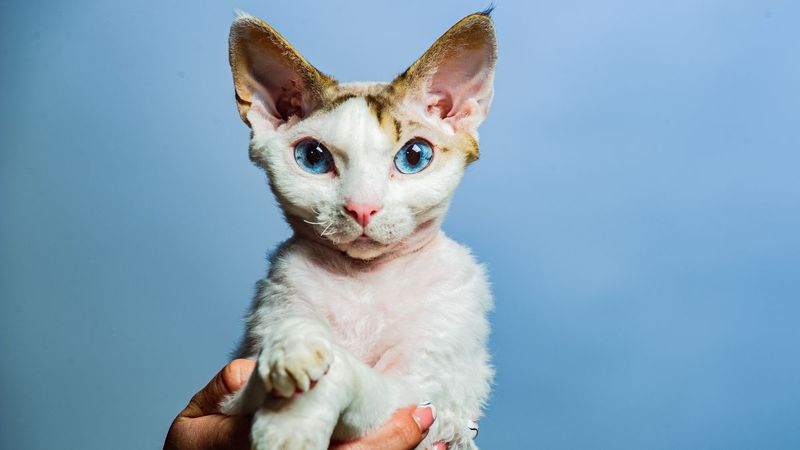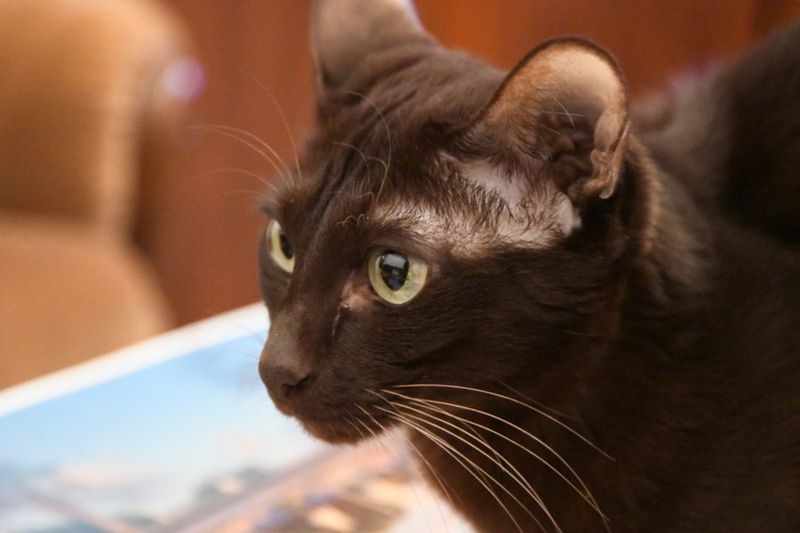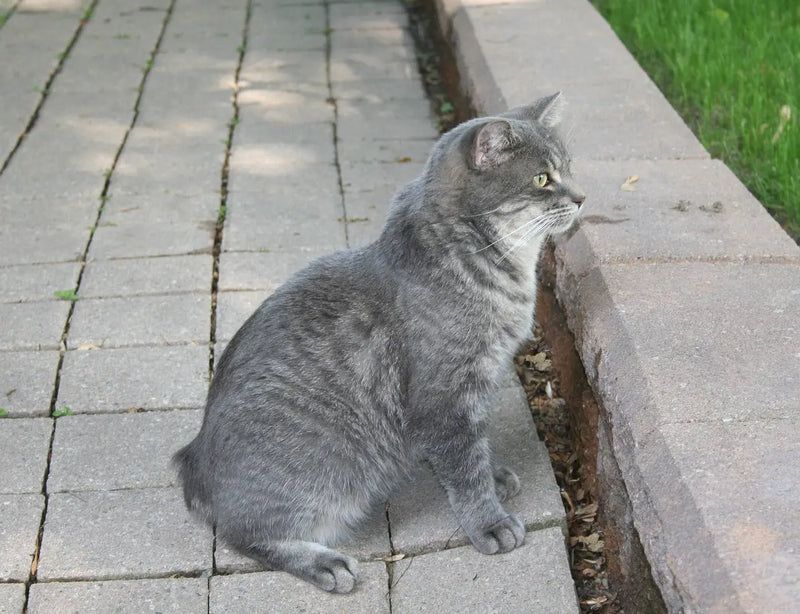📖 Table of Content:
Cats aren’t just cute companions – many are known for their remarkable intelligence and endless curiosity. From felines who can solve puzzles to those who have mastered tricks typically associated with dogs, these smart kitties prove there’s more to cats than meets the eye. The following breeds stand out for their problem-solving abilities, trainability, and natural curiosity that keeps their owners constantly amazed.
1. Abyssinian
Abyssinians possess extraordinary problem-solving skills that leave many owners astonished. These tawny-colored cats can figure out how to open doors, cabinets, and even some simple locks with persistent paw work.
Their intelligence isn’t just mechanical – Abyssinians show remarkable memory for routines and can recognize the sound of their owner’s car from others on the street. Many develop their own games when bored.
Unlike many cats, they maintain kitten-like curiosity well into adulthood, investigating every new object brought into their territory with careful examination rather than fearful hesitation.
2. Bengal
With their striking spotted coats, Bengals bring wild beauty and keen intelligence. They’re quick learners, easily figuring out how to unlock treats from challenging puzzle feeders that confuse many other cats.
Their water fascination reveals unusual intelligence – many learn to turn on faucets or flush toilets simply by watching their humans. Some Bengal owners report their cats understanding dozens of words and commands.
The Bengal’s need for mental stimulation means they’ll create entertainment if none is provided, sometimes leading to mischief like reorganizing shelves or testing gravity with your belongings. Their problem-solving abilities often surpass those of much larger pets.
3. Siamese
Beyond their famous vocalizations, Siamese cats showcase impressive ways to communicate. Their sleek color-point coats hide a talent for using different sounds and body cues to share their needs with you.
Their learning capacity rivals that of many dogs. Siamese cats readily learn tricks like fetching, high-fiving, and even walking on a leash with minimal training. Many owners report their Siamese understanding the names of household members and specific toys.
Particularly noteworthy is their ability to open doors by jumping and hanging on handles until the mechanism releases. Their intelligence extends to emotional awareness – many Siamese seem to sense when their humans are sad and offer comfort.
4. Scottish Fold
Though their folded ears give them an innocent look, Scottish Folds are sharp and observant. They quickly pick up on household activities and can mimic tasks such as flipping switches or opening drawers with ease.
Their problem-solving approach differs from more energetic breeds. Scottish Folds tend to study situations thoroughly before acting, leading many owners to underestimate their intelligence until discovering rearranged belongings or mysteriously opened containers.
These cats remember solutions to challenges for months or even years. One Scottish Fold owner reported her cat remembered how to access a particular hiding spot despite not using it for over two years.
5. Burmese
Combining intelligence with a playful nature that never quite grows up, Burmese cats stand out. Their strong memory allows them to remember where toys were hidden long ago and search those spots again and again.
These glossy dark cats show exceptional social intelligence. They quickly learn household routines and adjust their behavior to match different family members’ preferences. Burmese often surprise owners by bringing specific toys when they want particular games.
Their understanding of cause and effect surpasses most cats. Many Burmese figure out that certain behaviors (like gentle pats or specific meows) reliably produce desired responses from their humans, essentially training their owners rather than the reverse.
6. Cornish Rex
Cornish Rex cats combine unusual wavy coats with equally distinctive intelligence. These sleek, curly-haired felines show remarkable adaptability, quickly figuring out new environments and remembering complex routes through unfamiliar spaces.
Their dexterous paws function almost like hands, allowing them to manipulate objects with surprising precision. Many Cornish Rex cats learn to unscrew container lids or untie simple knots through patient experimentation. Their problem-solving often involves creative thinking rather than brute force.
These cats frequently develop preferences for specific puzzle types and will choose challenging toys over simple ones. Their intelligence extends to social learning – Cornish Rex cats readily pick up behaviors from both humans and other pets in the household.
7. Savannah
Sporting wild spotted coats, Savannahs also boast remarkable cognitive skills. They confidently leap distances that would scare many cats and flawlessly recall the layout of multi-floor homes.
Their problem-solving often involves collaboration. Many Savannah owners report their cats working together with other pets to achieve goals like opening doors or accessing restricted areas. Some learn to operate simple mechanisms after just a few observations.
Particularly remarkable is their ability to adapt strategies when initial attempts fail. Rather than repeating unsuccessful approaches, Savannahs typically try completely different methods until finding solutions. Their intelligence demands substantial mental stimulation to prevent destructive behaviors born from boredom.
8. Sphynx
Just because they’re hairless doesn’t mean Sphynx cats lack smarts. These clever cats often pick up on their owners’ moods and adjust their actions to offer comfort when it’s needed most.
Their learning style tends toward social observation. Sphynx cats carefully watch household activities, then demonstrate surprising understanding by anticipating routines or mimicking human behaviors. They readily learn words for favorite activities or objects.
Without fur for warmth, Sphynx cats have developed creative problem-solving for comfort. They identify the warmest spots in changing environments, create nests from available materials, and some even learn to operate heating pads or pull blankets over themselves when cold.
9. Maine Coon
Big and brainy, Maine Coons demonstrate impressive mechanical aptitude. They persistently experiment with latches, handles, and simple locks, using their large, skilled paws to manipulate objects beyond the reach of smaller cats.
Water fascination reveals their problem-solving skills. Maine Coons often learn to turn on faucets, flush toilets, or even operate water dispensers. Their intelligence extends to communication – many develop distinct vocalizations for different needs.
Perhaps most impressive is their ability to solve multi-step problems. Maine Coon owners frequently report their cats figuring out sequences like moving objects to create stepping stones to reach high places or distracting one family member to gain access to something another was guarding.
10. Balinese
Known for their smarts, Balinese cats adapt swiftly to their surroundings. As long-haired Siamese cousins, they learn daily routines fast and respond accordingly—often knowing exactly when it’s time for calm or fun.
Their problem-solving often involves creative thinking. Balinese cats frequently find unexpected routes to desired locations or objects, sometimes creating multi-step plans to achieve goals. Their memory for solutions is exceptional, remembering successful strategies months after first discovery.
Communication skills stand out in this breed. Balinese cats develop extensive vocabularies of sounds and gestures to express specific needs. They’re also unusually responsive to human communication, often seeming to understand complex instructions that would confuse other cats.
11. Turkish Van
With a reputation for swimming, Turkish Van cats stand out for their cleverness. They study water scenarios and carefully plan how to swim rather than avoiding it, showcasing problem-solving talents in many areas.
These distinctive white cats with colored head and tail markings show remarkable spatial reasoning. Many Turkish Van owners report their cats figuring out how to access seemingly impossible locations by creating stepping stone paths or finding leverage points others would miss.
Their adaptability reveals cognitive flexibility. Turkish Vans readily adjust to new environments, quickly mapping escape routes and identifying resources. This intelligence requires substantial stimulation – without adequate mental challenges, they often create their own entertainment by reorganizing household items.
12. Tonkinese
Blending Siamese and Burmese intelligence, Tonkinese cats make exceptionally clever pets. These medium-sized, pointed felines excel at reading social cues, figuring out how to get rewarded by different family members and changing their tactics as needed.
Their learning style emphasizes observation before action. Tonkinese cats often watch activities carefully many times before attempting them, resulting in surprisingly successful first attempts at complex tasks. Many learn to operate simple mechanisms like lever-style door handles.
Particularly impressive is their ability to generalize knowledge. A Tonkinese that learns one cabinet opening mechanism can typically apply that knowledge to similar but not identical latches elsewhere. Their intelligence requires engagement – these cats develop creative mischief when bored.
13. Japanese Bobtail
Japanese Bobtails pair distinctive stubby tails with exceptional intelligence focused on environmental manipulation. These active cats excel at rearranging their surroundings to create more comfortable spaces, sometimes moving bedding materials or toys to create elaborate nests.
Their problem-solving often involves social intelligence. Japanese Bobtails quickly learn which behaviors elicit desired responses from their humans and develop sophisticated communication systems. Many owners report their cats using different vocalizations for specific requests.
Memory stands out in this breed. Japanese Bobtails remember solutions to puzzles or locations of hidden items for remarkably long periods. Their intelligence often manifests as determined persistence – when faced with challenges, they typically try multiple approaches rather than giving up.
14. Russian Blue
Behind their quiet exterior, Russian Blues possess impressive intelligence. These silver-blue felines approach challenges methodically, preferring to think things through patiently rather than rushing into trial-and-error.
Observational learning defines their cognitive style. Russian Blues watch household activities intently, sometimes for weeks, before perfectly executing complex sequences like opening specific cabinets or operating simple devices. Their memory for these learned behaviors is exceptional.
Perhaps most impressive is their ability to recognize patterns in human behavior. Many Russian Blue owners report their cats anticipating routines with uncanny accuracy, appearing at precisely the right time for regularly scheduled activities even when the humans have forgotten. This intelligence pairs with unusual sensitivity to human emotions.
15. Korat
With remarkable determination, Korats display their intelligence through persistent problem-solving. These silver-blue cats from Thailand can spend hours focused on puzzles until they succeed, showcasing a concentration level rare among cats.
Their learning style emphasizes careful observation. Korats typically watch activities multiple times before attempting them, resulting in high success rates on first tries. Many Korat owners report their cats figuring out how to open specific doors or cabinets through patient study.
Social intelligence stands out in this breed. Korats quickly learn family members’ preferences and habits, adjusting their behavior to match each person’s expectations. Their cognitive abilities extend to emotional awareness – many seem to recognize when their humans are upset and offer comfort.
16. Singapura
Don’t let their size fool you—Singapuras are incredibly intelligent. These tiny ticked cats love to investigate how things function, often dismantling toys with their paws to satisfy their curiosity. They prefer active, physical problem-solving over passive observation.
Despite their small size, Singapuras demonstrate exceptional spatial reasoning. Many learn to create stepping stone paths to reach high places by moving objects into position. Their intelligence extends to understanding cause and effect relationships that many cats miss.
Memory stands out in this breed. Singapuras remember solutions to problems for months or even years, quickly recalling successful strategies even after long periods without encountering similar challenges. Their petite size sometimes leads people to underestimate their significant cognitive abilities.
17. Bombay
Sleek and intelligent, Bombay cats enjoy puzzle-solving. These mini-panthers approach challenges with determination, continuing to try new solutions until they succeed.
Their learning style emphasizes experimentation. Bombays typically try multiple approaches to problems, systematically testing different methods until discovering what works. Many owners report their Bombays figuring out how to open doors by jumping and hanging on handles.
Social intelligence defines this breed. Bombays quickly learn which behaviors earn attention or rewards from different family members and adjust their approach accordingly. Their cognitive abilities extend to understanding verbal cues – many Bombays learn to recognize numerous words for favorite activities or objects.
18. Devon Rex
Known for their curly coats, Devon Rex cats also shine with smart problem-solving abilities. These pixie-like cats use their nimble paws to operate latches, buttons, and touch screens with surprising precision.
Their learning approach emphasizes playful experimentation. Devon Rex cats try various solutions to challenges, seemingly enjoying the process as much as the eventual success. This playfulness shouldn’t be mistaken for a lack of focus – they often persist with problems that interest them.
Memory stands out in this breed. Devon Rex cats remember successful strategies for long periods and can apply learned solutions to similar but not identical problems. Their intelligence demands engagement – without adequate mental stimulation, they often create their own entertainment through creative mischief.
19. Havana Brown
Chocolate-colored Havana Browns reveal their intelligence by using all their senses when exploring. They look, sniff, and carefully touch objects with their paws to discover details about texture and movement.
Their problem-solving often involves systematic experimentation. Havana Browns typically try various approaches to challenges, carefully noting what works and what doesn’t. Many owners report their cats figuring out complex latching mechanisms through patient testing.
Communication skills reveal their cognitive abilities. Havana Browns develop extensive repertoires of sounds and gestures to express specific desires. Their intelligence requires engagement – these cats form strong bonds with their humans and prefer interactive play that challenges their minds over simple solo toys.
20. Manx
Proving tails aren’t needed for agility or intelligence, Manx cats excel at problem-solving. These tailless felines from the Isle of Man cleverly navigate challenges to get where they want, using inventive methods for jumping and climbing.
Their learning style emphasizes adaptation. Manx cats quickly adjust strategies when facing obstacles, finding alternative routes or methods with impressive resourcefulness. Many owners report their Manx cats figuring out how to open doors by jumping and hanging on handles.
Social intelligence defines this breed. Manx cats develop strong bonds with their families and seem to understand household dynamics better than most felines. Their cognitive abilities extend to understanding cause and effect relationships that many cats miss.
